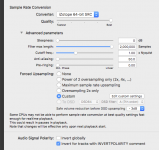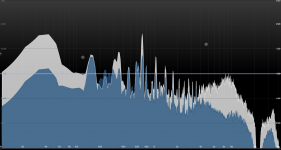I very much doubt images will trouble speakers. I do think amps in general distort more due to excess HF. Its not typically heard as distortion though, the subjective effect is either exaggerated leading edges or perhaps reduced dynamics, or both.
Amplifiers aren't usually meant to reproduce signals above 20khz strictly speaking. They will become increasingly non-linear if asked to do so.
I suspected this was why people bothered filtering such frequencies.
Last edited:
Not everyone goes to the trouble of filtering out image frequencies, particularly with NOS DACs like (for example) Audio Note and Border Patrol. Some designers use transformers which do provide a modicum of ultrasonic filtration by virtue of leakage inductance. I think Metrum also didn't do any filtering on their 'Octave' DAC, not sure if they do any now, on more recent models. There are probably others.
Are images @ 24k and above really such a bad thing if your amplifier/speakers can handle it?
In theory, they would be a problem if they generate amplifier intermodulation products in the audible band, or if they provoke oscillation in a poorly designed amplifier. However, this does touche on another controversial area. Since digital audio images are ultrasonic, even the lowest are above 22kHz, so they aren't audible, per se. Yet, there is significant difference in sound character between OS and NOS, which is particularly evident in the mid-band. This suggests that this difference in sound may be due to some other related factor.
I that think it was Lagadec who first identified that common digital interpolation filter algorithms produce repeating in-band frequency-domain response ripples. Those will then, via Fourier, overlay time-domain echoes of the signal upon itslef. This could be the source of much of the dissatisfaction with OS sound versus NOS sound, and not the presence or lack of ultrasonic images, nor Gibbs phenomena impulse ringing.
Last edited:
... so the importance of using the biggest possible upsampling in the analog to digital process ? It's what you meant? For the lowest in band phantom images.
But also mixing are made of multiple in band filters : noise gates, loudness war, echos, delays... so still a non ending story ?
Maybe the todays digital reccording process which have a higher upsampling rate than the 80s reccords are better suited for NOS and are giving today a less harsch NOS sound... perhaps !
Seems oversampling raw 44.1/44 K Hz materials with some playback software or Sox softaware improve nothing - i.e. remove not the in band digital images that stay at the reccording- ?
Too bad the DVD-Audio didn't find its market. On the digital filter side I also surprised the lossy Codec WMA from Microsoft gives sometimes better psychoacoustic results than a lossless one or the original disc : might it use the Pacific Microsonic filters during ripping which patents were purchased by Microsoft?
Would like to ask if staying with our old PCM chips without digital filters is a bad path according to all of you ?
But also mixing are made of multiple in band filters : noise gates, loudness war, echos, delays... so still a non ending story ?
Maybe the todays digital reccording process which have a higher upsampling rate than the 80s reccords are better suited for NOS and are giving today a less harsch NOS sound... perhaps !
Seems oversampling raw 44.1/44 K Hz materials with some playback software or Sox softaware improve nothing - i.e. remove not the in band digital images that stay at the reccording- ?
Too bad the DVD-Audio didn't find its market. On the digital filter side I also surprised the lossy Codec WMA from Microsoft gives sometimes better psychoacoustic results than a lossless one or the original disc : might it use the Pacific Microsonic filters during ripping which patents were purchased by Microsoft?
Would like to ask if staying with our old PCM chips without digital filters is a bad path according to all of you ?
Would like to ask if staying with our old PCM chips without digital filters is a bad path according to all of you ?
Just my own personal view - no, its not. What seems to me to be a diversionary ( I wouldn't say 'bad' as its opened up this particular interesting niche) path is the relentless drive towards lower THD+N in DAC chips without apparent concern for how the implementation sounds.
There is a point that is not clear to me, since I did not have the opportunity to listen or test to any oversampling DAC without a digital filter.
If you want to hear oversampling without interpolation filter with regular DAC, try Audirvana. It has a professional industry standard iZotope SRC with a lot of fine tuned options. It's free to try. You will hear the difference, and I'm sure you will prefer no interpolation filter if you can properly filter aliasing later. You'll find that ultra low quality FIR digital filter in DAC is the problem of regular DAC. I use 260000 step FIR.
Edit: If you want to add mastering quality FIR, insert Equilibrium plugin in Audirvana (free to try). With this plugin, you can see the aliasing noise in the spectral monitor, so you can fine tune your filter setting as you like. Expect considerable signal delay and a lot of CPU power if you want to set FIR to mastering level.
Last edited:
If you want to hear oversampling without interpolation filter with regular DAC, try Audirvana. It has a professional industry standard iZotope SRC with a lot of fine tuned options. It's free to try. You will hear the difference, and I'm sure you will prefer no interpolation filter if you can properly filter aliasing later. You'll find that ultra low quality FIR digital filter in DAC is the problem of regular DAC. I use 260000 step FIR.
I did a quick search on iZotope and they say they incorporate a steep low-pass filter to cut out aliasing when downsampling. No mention that they take it out of circuit when upsampling to cut out images. So what leads you to conclude that there's no interpolation filter in iZotope's SRC?
I did a quick search on iZotope and they say they incorporate a steep low-pass filter to cut out aliasing when downsampling. No mention that they take it out of circuit when upsampling to cut out images. So what leads you to conclude that there's no interpolation filter in iZotope's SRC?
I stumbled about that too, but think plasnu just objected against the usage of "built in" digital filters of DACs/cd-players etc. and proposes to use instead the better quality of an external SRC which doesn´t have to do the process in real time.
Which is a viable solution and might lead to better sound quality...
Plenty on that options page to suggest they're using a filter (max filter length, cutoff freq, min or lin phase) so let me ask once again - why do you say its not using a filter?
All other setting is ignored if you set filter 0dB. It just upsample without filter. I know it's somewhat confusing.
I surmise it could be unpopular because its receiving bad press - an SRC which doesn't use an FIR filter would be something of an oddity and users might prefer a product offering a more 'traditional' approach....
You can choose many different filter options in Audirvana including no filter. People just do not know it and don't know how to use them. Bad press? Check MQA thread. Those folks are traumatized with the digital audio technology, and it's very hard to convince them.
... so the importance of using the biggest possible upsampling in the analog to digital process ? It's what you meant? For the lowest in band phantom images. But also mixing are made of multiple in band filters : noise gates, loudness war, echos, delays... so still a non ending story ?
I'm uncertain if your response is addressed to me. However, assuming that it is, playback over/upsampling does not place images in-band. (Which, if it could, would then be termed aliasing.) Even via NOS, the lowest possible image frequency for CD rate content is 22KHz, which clearly is ultrasonic. Over/upsampling only further pushes the images up in frequency. So, no images can appear in-band for the D/A end of the chain. The A/D side is another matter, where aliasing is of concern, and so, a seperate topic. Intermodulation, however, can place distortion products in-band, but over/upsampling doesn't inherently prevent that better than NOS. For the sake of technical accuracy, I should mention that over/upsampled image bands exhibit an progressively decreasing amplitude, making any intermodulation products also exhibit decreasing amplitude.
Maybe the todays digital reccording process which have a higher upsampling rate than the 80s reccords are better suited for NOS and are giving today a less harsch NOS sound... perhaps !
There are advantages for NOS at higher native sample rates over NOS at CD rates, but there are numerous other technical details affecting the sound to declare a simple fixed preference.
Seems oversampling raw 44.1/44 K Hz materials with some playback software or Sox softaware improve nothing - i.e. remove not the in band digital images that stay at the reccording- ?
Remember, there are no in-band images produced during playback (well, except in the case where digital downsampling is improperly performed without prior image removal). All image bands are ultrasonic, existing above 22KHz (for CD) prior to digital interpolation filtering, and moved much higher after such filtering. Also, it should be noted that Sample Rate Conversion, such as Sox, is based on the digital filtering of image bands, just as with OS. The main difference is the performance of the filter, where PC based software filter implementations can easily be made more sophisticated than chip based hardware filter implementations.
Last edited:
There is a point that is not clear to me, since I did not have the opportunity to listen or test to any oversampling DAC without a digital filter.
If, we say, the main drawback of "oversampling" (vs. "NOS") is the use of the digital filter (for ringing and artifacts problems), is it possible to create an "oversampling" DAC without a digital filter, but still including a smooth analog filter?
If someone prefers the NOS sound, is the "oversampled DAC but without digital filter" sound competitive (still natural and musical, like NOS BUT much more detailed, live OS)?
Or, even tricky, if an analog reconstruction output filter design works good and enough with a NOS, would it sound better in a oversampled DAC (but without digital filter)?
The whole idea behind oversampling is to do be able to do the filtering in the digital domain.... NOS (Non Over Sampling) and Oversampling is just not possible....
- Status
- This old topic is closed. If you want to reopen this topic, contact a moderator using the "Report Post" button.
- Home
- Source & Line
- Digital Line Level
- Oversampled DAC without digital filter vs NOS

